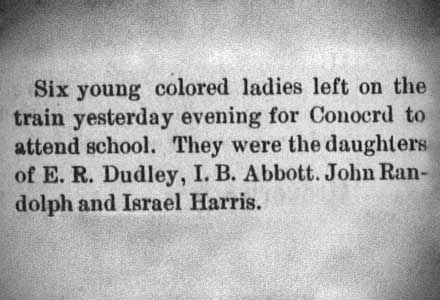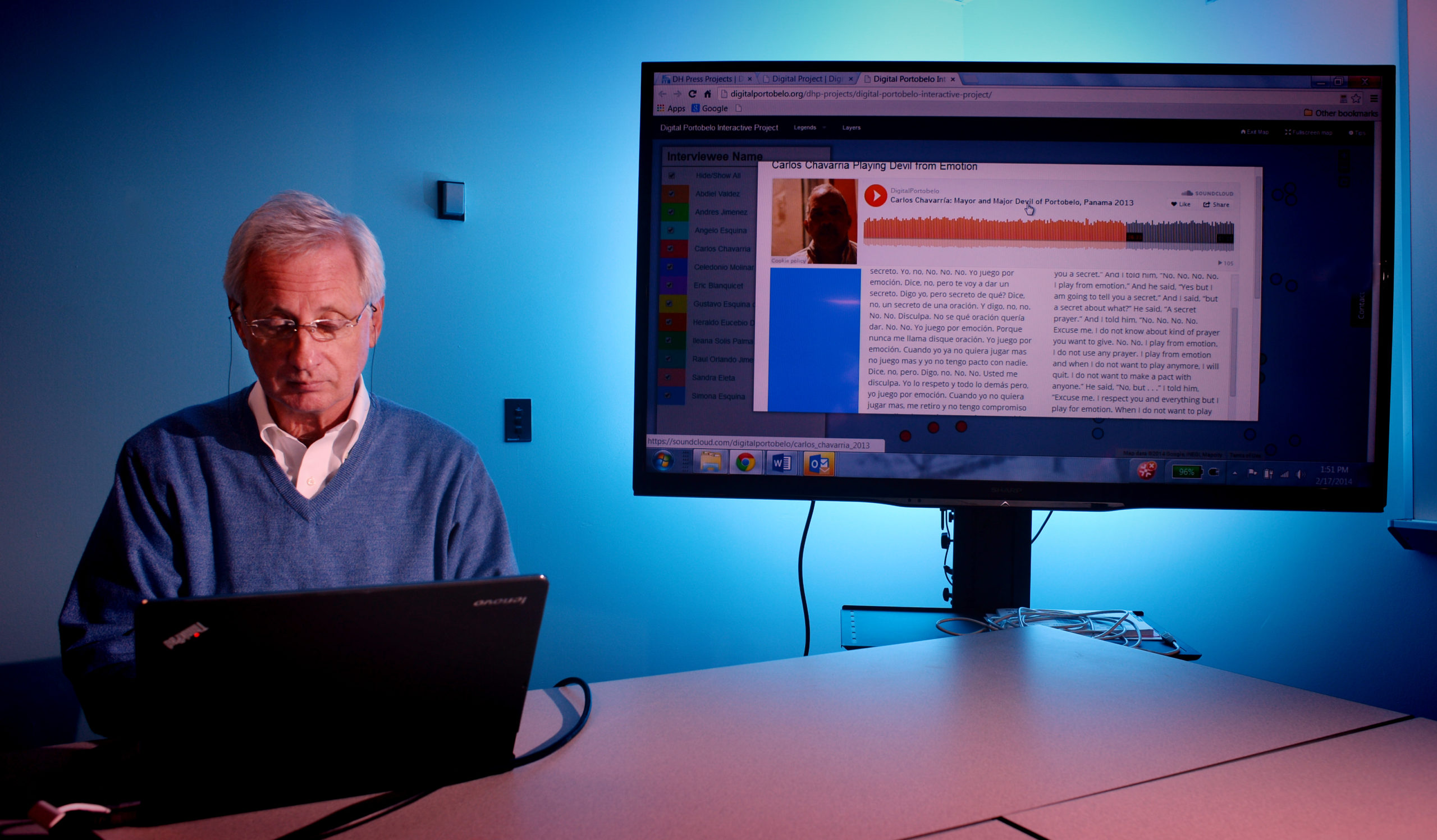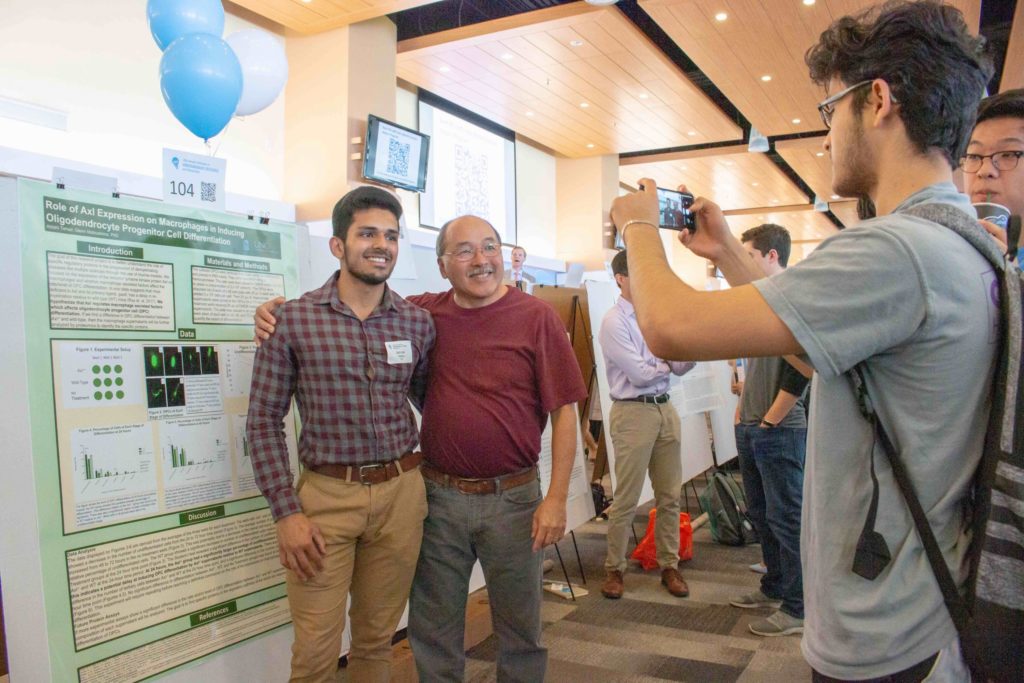
Details from the lives of black artisans in North Carolina, unseen for more than 100 years, are being discovered by UNC students using digital resources recently made available through Ancestry.com subsidiary Newspapers.com and the University library.
The students are in an American Studies first-year seminar, “The Family and Social Change in America.” On a recent afternoon, the 17 students sat around a rectangular arrangement of tables in the Digital Innovation Lab, with a large screen in one corner for everyone to see. Professor Robert Allen in the College of Arts and Sciences quickly turns their attention to the day’s main attraction.
Historian Catherine W. Bishir is ready to engage the students. Bishir is the author of Crafting Lives (UNC Press, 2013) and curator of Architectural Records Special Collections at North Carolina State University Libraries.
The students have read Bishir’s book, in which she looks at the lives of free and enslaved black artisans in New Bern, N.C., from 1770-1900. Each student was assigned an artisan from Bishir’s book and told to look for more details about that person – dressmaker, cobbler, cooper, brickmason and others – who lived in the port city on the Neuse River off Pamilico Sound.
Students among the first to use new digital tool

In researching the artisans, the students are among the first to use millions of newly digitized and searchable North Carolina newspaper pages. Partnering with the UNC library, Newspapers.com is digitizing some 3,000 microfilm reels of pre-1923 newspapers in UNC’s North Carolina Collection and publishing them immediately. All UNC faculty, staff and students have access to the digital records on Newspapers.com.
The process will capture more than two million pages, and is proceeding city by city. New Bern, with 171 years of pre-1923 newspapers, was the first to be finished. When Allen heard about Bishir’s book, he rushed to get it and set up the opportunity for his students to do primary research.
As class begins, the students introduce themselves and tell a bit about the artisan whom they researched. Allen, the James Logan Godfrey Distinguished Professor of American Studies and Director of the Digital Innovation Lab, opens a Google docs site in which the class has stored and shared their findings, showing an image of each clip on the large screen.
“What’s going on here and why might we think this is important?”

During the discussion, Allen posts the snippet about the “six young colored ladies” from an 1882 issue of the New Bern Daily Journal that student Thomas Haire uncovered. Allen asks, “What’s going on here and why might we think this is important?”
The students pose several ideas:
- “They are probably teenagers and they knew each other.”
- “They actually had relationships inside and outside their families.”
- “It may show the affluence of their families to be able to send them to a school hours away.”
- “They’re not only black, but women who are being educated.”
Bishir revels in Haire’s find. “First, I just pictured this event. Young women, who must be in their early teens, getting on the train. Their families are there in their best outfits. They’ve completed some amount of education, presumably, and their families are supportive. And they’re all at the train station and mama’s crying . . . you can imagine all sorts of things. They’ve got their carpet bags, and it’s a long way from New Bern to Concord. It doesn’t say anything about any grownups going with them, but they might have.”
Bishir is struck by the phrase “young colored ladies.”
“That was at a time in race relations when newspapers may have used that phrase, but later on during times of white supremacy and Jim Crow, they would not have called them ladies, maybe girls or maybe not even run the story,” Bishir says.
‘Whoa! Think about that!’
“If I remember correctly, all the fathers were born in slavery and now they’re sending their daughter to school. Whoa! Think about that! This is one of the ones that, had I been able to find before, I would have put it in (the book). It is such a rich story.”
The clip is just one example of how the book and the students’ research through new digital resources knit together the artisans’ roles as family members and workers who are, as the book states, “striving for freedom, education and opportunity.”
“I wanted to link this undergraduate class with the work we are doing in the Digital Innovation Lab and to take advantage of the digitization of the pre-1923 NC newspapers by Newspapers.com,” Allen says.
As class discussion continues, Allen bounces between student comments and Google docs to show their findings.
“If you had told these men and women that you all would be doing this, they would not believe it,” Bishir says. “Nobody ever knows what history is going to attach to them. It’s remarkable that this technology and a professor’s focus and your interest are uncovering the lives of people who, for much of early 20th century in North Carolina, we specifically did not discuss.”
Bishir asks the students about how the research may have changed how they think.
Student Annie Proctor says that the class findings enhanced her understanding of race relations after the Civil War.
Bishir agrees: “Yes, there’s a common misconception that there was slavery, then the Civil War, then reconstruction, then Jim Crow. At least in some places, there’s a big gap with people trying to realize the American dream.”
Other Newspapers.com finds
Other Newspapers.com finds by the students address issues such as property ownership (including payment of a dog tax), marriage records, legal proceedings, political matters, attitudes about temperance and many others. Many of the same names appear as they see the roles the artisans played in civic, political, social and church settings.
They discuss how their research findings match with how the legacy of Jim Crow shaped people’s concept of the past. To Allen, one important part of the class is the first-time opportunity for most students to conduct primary source research; read a historical monograph; meet the author of a historical monograph; or read a nineteenth-century newspaper.
The class will continue through the semester, reading, researching and talking with other historians such as Bishir and UNC’s Heather Williams.
“Reading Bishir’s book and finding these artisans for themselves in the newspapers of more than a century ago completely changed the students’ understanding of slavery, African American life in North Carolina and the vital role of artisans in 19th century social and political life in a place like New Bern,” Allen says. “This is scholarly research on the bleeding edge, with sources that no one else has used. And, the students get to work with and connect with distinguished authors of history.”
- Read more about the Department of American Studies and the Digital Innovation Lab, both parts of UNC’s College of Arts and Sciences.
[ By Scott Jared, University Relations]




